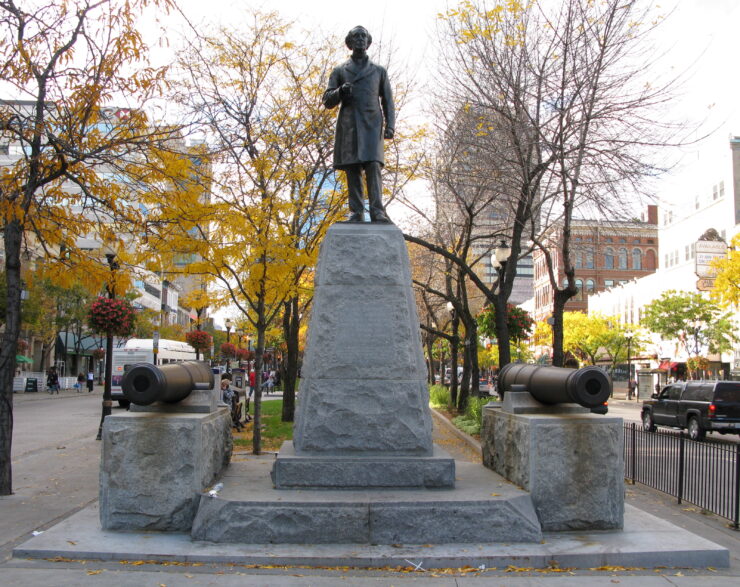In August of this year, Victoria became the first city to remove a statue of Sir John A. MacDonald from their city hall, as the controversial figure has a legacy of atrocities committed against Canada’s Indigenous peoples. This has sparked debate nationwide about the memorialization of the country’s first prime minister, specifically in Ottawa. You really can’t go far off campus without seeing a statue of MacDonald—not to mention that there’s a pub and a parkway named after him too.
So should statues of the country’s first prime minister be removed in the name of reconciliation, or is this practice damaging to our history?
The statues should be removed, or at least moved
Although it’s undeniable that Sir John A. MacDonald laid the foundation for Canada as it is today, he did so on the backs of Indigenous communities. He introduced residential schools, did little to help famines that ravaged in federal reserves, orchestrated mass executions, the list of atrocities goes on.
And that’s the problem. There is absolutely no way that a small plaque right by MacDonald’s statue on Parliament Hill will be able to bear all the information of the atrocious acts he committed. Nor will the tourists milling about the Hill care to stop and read it. We cannot erase history, but we must ensure that history is learned in the first place, in a way that is true, accurate and leaves no detail behind.
Which is why I think the statues should be removed.
I don’t believe MacDonald should be wiped from the history books, or that we should ignore his accomplishments and what he did for Canadian society. However, I do think we need to do better to teach about our colonial past, and what cost Indigenous communities paid at the hands of Canada’s first prime minister.
I think statues of MacDonald should remain, but should remain in the museum. If we are unable to educate the masses through having his statues in public with all the information available, then we should put displays of him in museums, where people go to learn about history. Not in the street, where he is to be praised or glorified. Then, people will be able to make their own conclusions.
Through placing the statues in museums and putting all the facts in the history books, we must also make sure this information is not only accessible to those who can afford to access such things. Having a public gallery, like the Ottawa Art Gallery by Rideau Center, where there is ample wallspace to display information is a much better alternative to having him glorified on the top of a monument with Confederation below him.
—Hanna Methot, opinions editor.
The statues should stay up
I sympathize with calls to remove statues of Sir John A. MacDonald. I do not think these calls are unfounded and I do not think they’re illegitimate. In fact, I think they are a net positive. They are forcing us to have a conversation that is extremely worthwhile and entirely necessary. MacDonald did some messed up stuff. That being said, I think once one digs into the question a little deeper, it becomes completely clear that removing MacDonald’s statue is not the best way forward.
Firstly, it is crucial to remember that art does not serve primarily to comfort or console our sensitive sensibilities. In many ways, art serves as a conduit to confronting realities that are uncomfortable or even horrifying. Moreover, our interpretation of art is not concrete and unmalleable. As Canadian society becomes more informed of and more willing to grapple with our troubled past, the statue which was initially erected to unabashadley venerate MacDonald will take on an emotional cloudiness much more representative of the dilemma he presents us with.
The argument that it causes pain and therefore ought to go is, as it appears to me, very problematic. We maintain Holocaust memorials. Certainly these memorials bring back unbearable feelings of anguish and suffering for many people. But we maintain the memorials because it’s important to remember that pain, and it’s important to remember what we as a species are capable of doing to one another. Getting rid of MacDonald does nothing to change what has already happened, and it makes it easier for us to forget and ignore what we ought to face head on.
Sometimes, tearing down statues is illustrative of change, like the tearing down of the Hussein statue in Syria, or to a lesser extent the Berlin Wall. But in these cases, the tearing down happened after the change was achieved. The obliteration of the statue was merely the cherry on top.
In this case, we’re putting the cart before the horse; Canada is nowhere near accomplishing reconciliation , yet we’re already willing to jump the gun and pat ourselves on the back? We’re pretending to have made progress where we haven’t. Genuine progress is harder than than tearing down statues.
This to me is another example of the conversation being shifted away from where it ought to be because we’re scared to do what it really takes. If we’re serious about owning up to and making amends with our not so distant past, then what we ought to be grappling with is the findings of the Truth and Reconciliation Committee. This was a six-year study conducted at the behest of the government concerning what we’ve done wrong in our past, and what we should do going forward.
The findings of the committee are radical. It involves everything from establishing new forms of government, to hugely expanding forms of child welfare, to doing whatever it takes to lower the overrepresentation of Indigenous people in our justice system. Indeed, the list of recommendations the committee makes is long, exhaustive, and very obviously bled over in great detail.
Despite the nature of the list, nowhere does the committee recommend that we should be spouting mere lip service about reconciliation and spend our time erasing problematic parts of history. The mandate of the committee was the exact opposite, and the recommendations raised are indicative of a conversation we need to have ASAP—much more so than a mere discussion about statues.
—Connor Chase, Fulcrum contributor.




